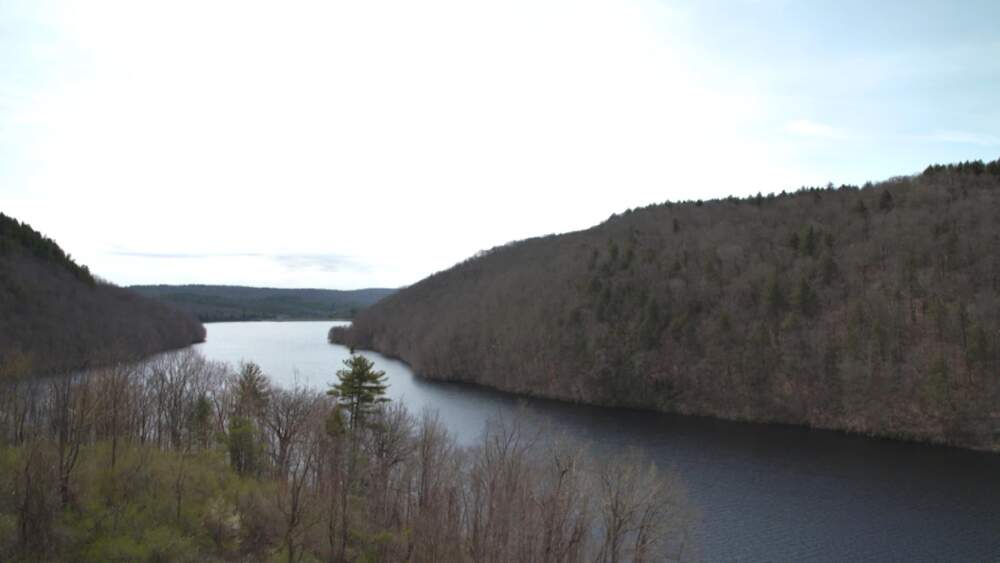Advertisement
Environmentalists reach agreement to keep land on the Conn. and Mass. border undeveloped

Environmentalists have reached an agreement with a regional water commission to ensure that 5,500 acres of land in northwestern Connecticut and Massachusetts remains undeveloped.
The deal is a major victory for conservationists. It would keep the land open for the public and averts development on a critical piece of land that feeds into the Farmington River.
“The lands ... are extraordinarily beautiful and unlike landscapes that you see in most of Connecticut,” said Catherine Rawson, executive director of the Northwest Connecticut Land Conservancy (NCLC).
The future of the land was called into question after the Metropolitan District Commission (MDC) announced it wanted to give up some of its rights to store water in the Colebrook Reservoir — citing costs to maintain aging infrastructure. That deal is still pending before state officials.
The Colebrook Reservoir is massive, holding billions of gallons of water. To keep it clean, strict rules govern nearby development. But if state regulators approve the MDC's "abandonment permit" for the area, those watershed protections could go away, potentially opening the door for development.
On Tuesday, the NCLC and Save the Sound said they reached a memorandum of understanding with the MDC to negotiate a conservation easement on the approximately 5,500 acres, which includes 4,300 acres in Connecticut and about 1,200 acres in Massachusetts.
The history of the Colebrook River Reservoir and its surrounding land stretches back decades.
The reservoir began operations in 1969. It was built mainly as a flood control dam following historic floods from back-to-back hurricanes in August of 1955 that left 77 Connecticut residents dead.
Under a contract between the MDC and the the U.S. Army Corps of Engineers, the MDC would have had 3.5 billion gallons of storage in Colebrook Reservoir, along with 10 billion gallons of stored emergency drinking water.
But since that contract was signed in 1969, the 10 billion gallons of emergency drinking water supply has never been used, according to the MDC.
The agency says there is no infrastructure for this water to be transported into MDC’s drinking water supply system, which comes from the Barkhamsted and Nepaug Reservoirs. It also says payments to the U.S. Army Corps of Engineers to maintain the Colebrook dam outweigh the benefits to ratepayers.
While local leaders agree, nearby residents have stressed the area's critical importance to local ecosystems and their desire to see it remain undeveloped.
“It is important to note that each of the four Colebrook Reservoir towns — Barkhamsted, Colebrook, New Hartford, and Hartland — have submitted letters of support of the MDC’s abandonment application," Scott Jellison, MDC chief executive officer, said in a statement. "For decades, these towns and their residents have partnered with the MDC and its staff in ensuring that the land surrounding the Colebrook Reservoir is maintained as a protected watershed and available for passive recreation."
Under the deal, the land conservancy will pay the MDC $1 million for the development rights to the land, if the water agency is allowed by the state Department of Public Health to give up the water storage permit.
NCLC would purchase a conservation easement on 5,500 acres of MDC-owned land. MDC will be permitted to continue its existing uses of the property. New public access to the property will be allowed for hunting, fishing, hiking, and boating, subject to NCLC and state approval.
Residential, industrial, commercial and other forms of development would not be allowed.
If finalized, environmentalists said the deal would be the biggest area of land to be preserved in Connecticut since an agreement was reached to conserve Aquarion Water Company property two decades ago. According to Save the Sound, water companies are the second largest owners of open space in the state.
NCLC's Rawson said preserving the land is a key win for the state's residents, its animals and its ecology
“It's a really monumentally beautiful landscape, with steep forested slopes, cool clean rivers, and abundant habitat for both rare species and migratory species,” Rawson said.
This story is a production of the New England News Collaborative. It was originally published by Connecticut Public.